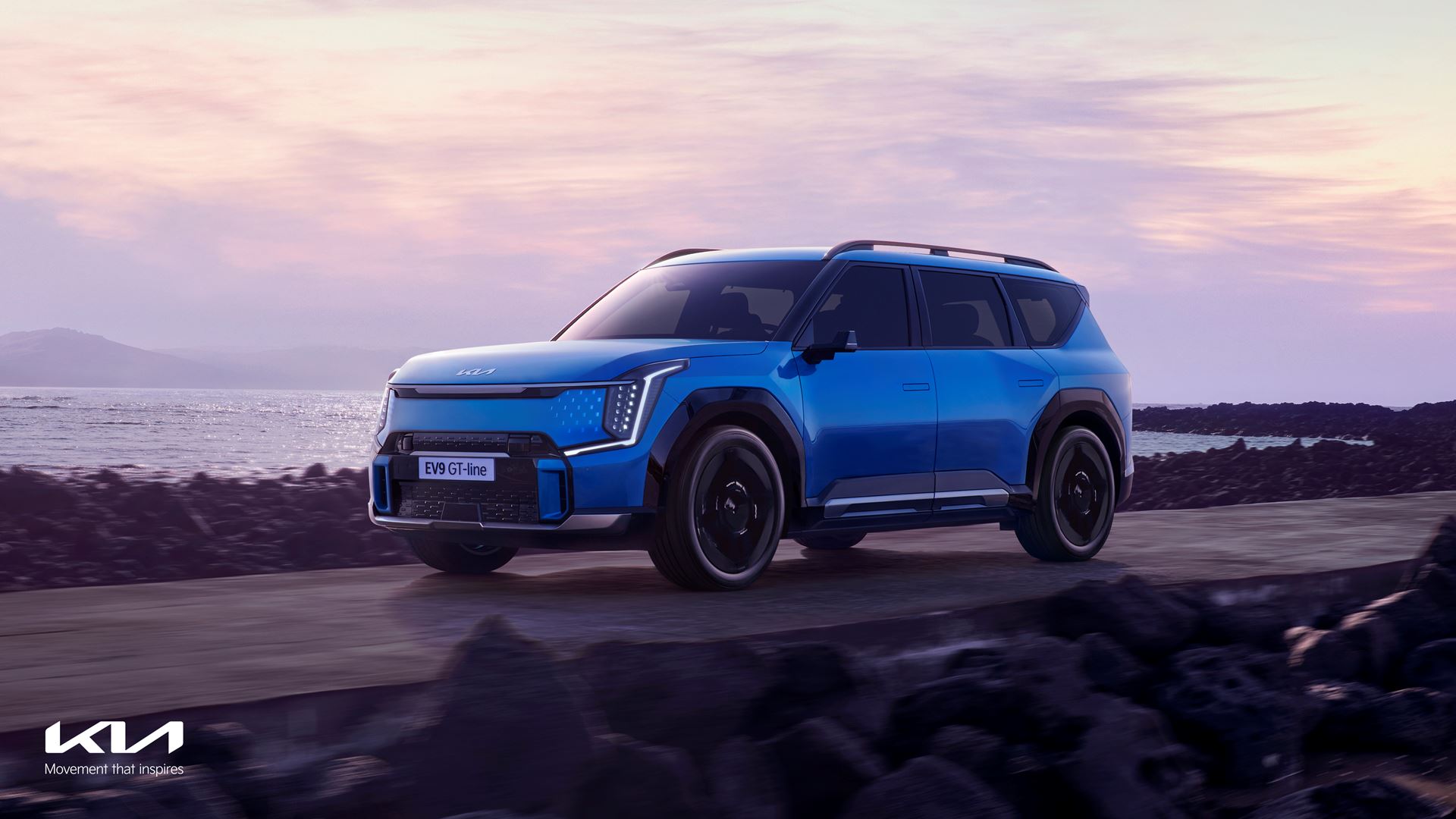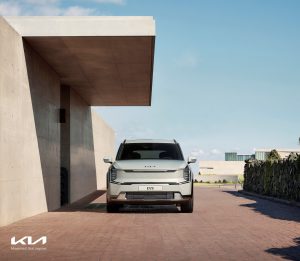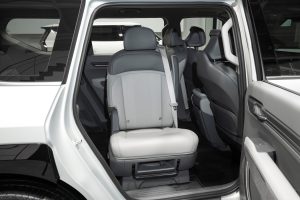Kia has released the specifications for the upcoming EV9, the Korean automaker’s first full-size electric SUV.
Until recently, electric vehicle offerings for those looking to travel with more than five people have been relatively limited, especially as vehicles like the Rivian R1S remain fairly supply constrained. Luckily, Kia is moving in to meet that market with its new EV9 full-size electric SUV, which it has now released the specifications for.
The upcoming Kia EV9, which will be available in select markets later this year, comes with two battery options; either a “standard-range” 76.1kWh battery or a “long-range” 99.8kWh battery. Further, customers can choose from a single-motor rear-wheel-drive system or a dual-motor all-wheel-drive system.
With the long-range RWD system, owners can expect 336 miles of range, an incredible number considering the massive size of the upcoming EV9. However, Kia did not release range specifications for other vehicle trims.
With a total length of just under 16.5 feet, the Kia EV9 is roughly the same length as the Tesla Model X and just shy of the size of a Chevy Tahoe. But coming in at almost 5’10” tall, the EV9 is significantly shorter than the Tahoe while slightly taller than the Model X.
- Credit: Kia
It is clear from the EV9’s performance specifications that the vehicle focuses on people carrying, not eye-watering performance. The base model’s long-range RWD variant takes nearly 10 seconds (9.4 seconds) to reach 60mph from a standstill. For those looking for slightly more performance, Kia offers a minor motor upgrade with the standard range variant, improving horsepower from 200 to 215 while retaining the same 258 pound-feet of torque, cutting the 0-60 time to 8.2 seconds.
The highest performance trim, the dual-motor AWD system, produces a significantly more impressive 379 horsepower and a very healthy 442 pound-feet of torque. Kia states that this trim will take off to 60 in 6 seconds and can even be upgraded via software to improve acceleration, dropping the 0-60 to 5.3 seconds.
Outside of these mechanical specifications, the Kia EV9 pioneers the use of more sustainable materials, which Kia says will become increasingly more common in all of its upcoming models. This includes recycled plastics and numerous plant-based materials, such as sugar cane, corn, and “natural oils.”
Looking at the Kia EV9 as a whole, the automaker’s design philosophy becomes more apparent, and the connection to its logical competitor, the Tesla Model X, becomes less clear. Kia is offering a people-carrying-focused experience that isn’t going to shock anyone when you take off down a highway onramp. Nor is the Korean company offering a “take on the world” off-roader akin to the Rivian R1S. And nowhere are these choices more apparent than in the vehicle’s interior.
Opening the massive doors to the EV9, you are greeted with two sets of captain’s chairs, not bucket seats, and a set of rear captain’s chairs that will pivot and swivel to face the window or even third-row occupants. Kia has one target market in mind; families.
Kia is showing off the EV9 in person starting later this month at the Seoul Auto Show in South Korea, followed by an appearance at the New York Auto Show in early April. Kia will launch the EV9 later this year and reveal pricing information closer to launch, though many expect a competitive price point for the Korean family hauler.
What do you think of the article? Do you have any comments, questions, or concerns? Shoot me an email at william@teslarati.com. You can also reach me on Twitter @WilliamWritin. If you have news tips, email us at tips@teslarati.com!

Elon Musk
Elon Musk and Tesla AI Director share insights after empty driver seat Robotaxi rides
The executives’ unoccupied tests hint at the rapid progress of Tesla’s unsupervised Robotaxi efforts.

Tesla CEO Elon Musk and AI Director Ashok Elluswamy celebrated Christmas Eve by sharing personal experiences with Robotaxi vehicles that had no safety monitor or occupant in the driver’s seat. Musk described the system’s “perfect driving” around Austin, while Elluswamy posted video from the back seat, calling it “an amazing experience.”
The executives’ unoccupied tests hint at the rapid progress of Tesla’s unsupervised Robotaxi efforts.
Elon and Ashok’s firsthand Robotaxi insights
Prior to Musk and the Tesla AI Director’s posts, sightings of unmanned Teslas navigating public roads were widely shared on social media. One such vehicle was spotted in Austin, Texas, which Elon Musk acknowleged by stating that “Testing is underway with no occupants in the car.”
Based on his Christmas Eve post, Musk seemed to have tested an unmanned Tesla himself. “A Tesla with no safety monitor in the car and me sitting in the passenger seat took me all around Austin on Sunday with perfect driving,” Musk wrote in his post.
Elluswamy responded with a 2-minute video showing himself in the rear of an unmanned Tesla. The video featured the vehicle’s empty front seats, as well as its smooth handling through real-world traffic. He captioned his video with the words, “It’s an amazing experience!”
Towards Unsupervised operations
During an xAI Hackathon earlier this month, Elon Musk mentioned that Tesla owed be removing Safety Monitors from its Robotaxis in Austin in just three weeks. “Unsupervised is pretty much solved at this point. So there will be Tesla Robotaxis operating in Austin with no one in them. Not even anyone in the passenger seat in about three weeks,” he said. Musk echoed similar estimates at the 2025 Annual Shareholder Meeting and the Q3 2025 earnings call.
Considering the insights that were posted Musk and Elluswamy, it does appear that Tesla is working hard towards operating its Robotaxis with no safety monitors. This is quite impressive considering that the service was launched just earlier this year.
Elon Musk
Starlink passes 9 million active customers just weeks after hitting 8 million
The milestone highlights the accelerating growth of Starlink, which has now been adding over 20,000 new users per day.

SpaceX’s Starlink satellite internet service has continued its rapid global expansion, surpassing 9 million active customers just weeks after crossing the 8 million mark.
The milestone highlights the accelerating growth of Starlink, which has now been adding over 20,000 new users per day.
9 million customers
In a post on X, SpaceX stated that Starlink now serves over 9 million active users across 155 countries, territories, and markets. The company reached 8 million customers in early November, meaning it added roughly 1 million subscribers in under seven weeks, or about 21,275 new users on average per day.
“Starlink is connecting more than 9M active customers with high-speed internet across 155 countries, territories, and many other markets,” Starlink wrote in a post on its official X account. SpaceX President Gwynne Shotwell also celebrated the milestone on X. “A huge thank you to all of our customers and congrats to the Starlink team for such an incredible product,” she wrote.
That growth rate reflects both rising demand for broadband in underserved regions and Starlink’s expanding satellite constellation, which now includes more than 9,000 low-Earth-orbit satellites designed to deliver high-speed, low-latency internet worldwide.
Starlink’s momentum
Starlink’s momentum has been building up. SpaceX reported 4.6 million Starlink customers in December 2024, followed by 7 million by August 2025, and 8 million customers in November. Independent data also suggests Starlink usage is rising sharply, with Cloudflare reporting that global web traffic from Starlink users more than doubled in 2025, as noted in an Insider report.
Starlink’s momentum is increasingly tied to SpaceX’s broader financial outlook. Elon Musk has said the satellite network is “by far” the company’s largest revenue driver, and reports suggest SpaceX may be positioning itself for an initial public offering as soon as next year, with valuations estimated as high as $1.5 trillion. Musk has also suggested in the past that Starlink could have its own IPO in the future.
News
NVIDIA Director of Robotics: Tesla FSD v14 is the first AI to pass the “Physical Turing Test”
After testing FSD v14, Fan stated that his experience with FSD felt magical at first, but it soon started to feel like a routine.

NVIDIA Director of Robotics Jim Fan has praised Tesla’s Full Self-Driving (Supervised) v14 as the first AI to pass what he described as a “Physical Turing Test.”
After testing FSD v14, Fan stated that his experience with FSD felt magical at first, but it soon started to feel like a routine. And just like smartphones today, removing it now would “actively hurt.”
Jim Fan’s hands-on FSD v14 impressions
Fan, a leading researcher in embodied AI who is currently solving Physical AI at NVIDIA and spearheading the company’s Project GR00T initiative, noted that he actually was late to the Tesla game. He was, however, one of the first to try out FSD v14.
“I was very late to own a Tesla but among the earliest to try out FSD v14. It’s perhaps the first time I experience an AI that passes the Physical Turing Test: after a long day at work, you press a button, lay back, and couldn’t tell if a neural net or a human drove you home,” Fan wrote in a post on X.
Fan added: “Despite knowing exactly how robot learning works, I still find it magical watching the steering wheel turn by itself. First it feels surreal, next it becomes routine. Then, like the smartphone, taking it away actively hurts. This is how humanity gets rewired and glued to god-like technologies.”
The Physical Turing Test
The original Turing Test was conceived by Alan Turing in 1950, and it was aimed at determining if a machine could exhibit behavior that is equivalent to or indistinguishable from a human. By focusing on text-based conversations, the original Turing Test set a high bar for natural language processing and machine learning.
This test has been passed by today’s large language models. However, the capability to converse in a humanlike manner is a completely different challenge from performing real-world problem-solving or physical interactions. Thus, Fan introduced the Physical Turing Test, which challenges AI systems to demonstrate intelligence through physical actions.
Based on Fan’s comments, Tesla has demonstrated these intelligent physical actions with FSD v14. Elon Musk agreed with the NVIDIA executive, stating in a post on X that with FSD v14, “you can sense the sentience maturing.” Musk also praised Tesla AI, calling it the best “real-world AI” today.

















